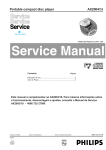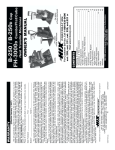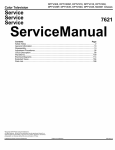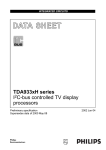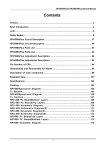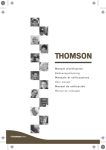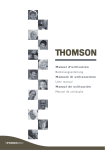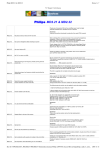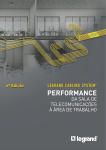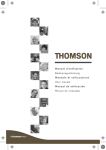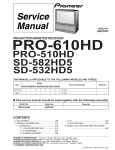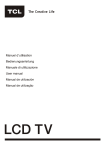Download Service Manual
Transcript
Service Manual ___________________________________________________________________________________ Chassis Professional 8000 ___________________________________________________________________________________ Service notes After a repair the cables must be laid out as originally fitted to save compliance with original approval and to avoid failures or disturbances. The mains cable prevents interference from the mains supply and is part of the product approval. For replacement the original spare part only must be used. Note di servizio Dopo una riparazione i cavi devono essere disposti come posizionati all’origine per mantenere la corrispondenza con le approvazioni originali ed evitare guasti o disturbi. Il cavo di alimentazione previene interferenze provenienti dalla rete elettrica ed è parte delle approvazioni del prodotto. Per la sostituzione deve essere utilizzato esclusivamente il ricambio originale. Modifications reserved - Con riserva di modifiche Service procedure for Chassis Professional 8000 Power supply Adjust PP1 for 140 V +/- 0.5 V across CP37. Entering service mode 1. Turn on the appliance at the mains switch while holding down the MENU key on the local control until the red LED lights up. 2. Release the MENU key on the local control and press the stand-by key on the remote control. The appliance will start up in service mode with a specific support menu. 3. The various functions can be selected using the P+ and P- keys on the remote control and the adjustment can be made using the Volume + keys. It is advisable to make a note of the initial value before making the adjustment so that it can easily be restored if necessary. If the memory NVM (ICR3) is replaced, it is essential to carry out all the adjustments required in service mode because the replacement memory is supplied NOT preprogrammed. If the EPROM (ICR2) containing the software is replaced, compatibility with the existing NVM is verified automatically and if necessary it is initialised. These operations may take some time, so you must wait until they are completed. Although the individual settings can be accessed and memorised individually and independently, it is advisable to carry them out in the sequence in which they appear when pressing the P- key. Option byte The correct value to be set for each appliance is marked on the label on the back of each item alongside the writing Option byte. The value can be entered using the number keys on the remote control. AFC setting Connect a generator (or a known transmitter of reliable quality) to the antenna input and use the remote control number keys to enter the value of its RF frequency (which must be within the frequency band indicated by the menu), then press OK. The setting will be made automatically. Repeat the procedure for BG, L and L’ standards. If any of the settings are omitted, operation, automatic search and tuning in this standard may be incorrect. AGC tuner setting Connect a generator with an RF level of 1 mV (60 dBµV) (or a known transmitter of reliable quality) to the antenna input and use the remote control number keys to enter the value of its frequency (which must be within the frequency band indicated by the menu), then press OK. The setting will be made automatically. Screen grid voltage (Vg2) Adjust the potentiometer G2 on the transformer EHT until the confirmation message appears. No particular signal set-up is required. Vertical geometry The VS (Vertical Slope) function must be adjusted in such a way that the central horizontal line in the test signal is exactly on the border between the visible image and the lower black part. It must not subsequently be altered. Now set the remaining parameters as accurately as possible in the sequence in which they appear. Horizontal geometry Adjust as accurately as possible in the sequence in which they appear. Adjusting white (Red/Green) Using a B/W bar signal, adjust to obtain a grey image. The blue setting is fixed. Exiting service mode Once you have made the necessary adjustments, press the OK key on the remote control in one of the menus in which it is active to memorise all the functions and return to normal operation of the appliance. Oscillograms Chassis Professional 8000 (1/5) 0V 0V 1 1 V/Div 10 µs/Div 0V 2 1 V/Div 10 µs/Div 3 1 V/Div 10 µs/Div 6 20 V/Div 10 µs/Div 9 100 V/Div 5 µs/Div 12 100 V/Div 5 µs/Div 15 1 V/Div 5 ms/Div 0V 0V 4 20 V/Div 10 µs/Div 0V 5 20 V/Div 10 µs/Div 0V 0V 0V 7 100 V/Div 8 5 µs/Div 5 V/Div 5 µs/Div 0V 0V 10 500 mV/Div 5 µs/Div 0V 11 2 V/Div 5 µs/Div 0V 0V 13 2 V/Div 10 µs/Div 14 500 mV/Div 10 µs/Div 0V 1 Oscillograms Chassis Professional 8000 (2/5) 0V 0V 0V 16 1 V/Div 10 µs/Div 0V 17 5 V/Div 10 µs/Div 0V 19 200 V/Div 10 µs/Div 18 2 V/Div 10 µs/Div 21 50 V/Div 10 µs/Div 0V 20 5 V/Div 5 ms/Div 0V 0V 0V 22 50 V/Div 23 5 ms/Div 10 V/Div 5 ms/Div 24 10 V/Div 10 µs/Div 27 50 V/Div 10 µs/Div 30 1 V/Div 10 µs/Div 0V 0V 25 50 V/Div 10 µs/Div 0V 0V 26 50 V/Div 5 ms/Div 0V 28 5 V/Div 10 µs/Div 0V 29 1 V/Div 10 µs/Div 2 Oscillograms Chassis Professional 8000 (3/5) 0V 0V 31 1 V/Div 0V 32 10 µs/Div 500 mV/Div 10 µs/Div 0V 33 500 mV/Div 10 µs/Div 0V 0V 34 500 mV/Div 10 µs/Div 35 1 V/Div 10 µs/Div 0V 1 V/Div 38 5 ms/Div 1 V/Div 5 ms/Div 39 1 V/Div 10 µs/Div 0V 0V 37 36 2 V/Div 10 µs/Div 0V 0V 40 2 V/Div 10 µs/Div 0V 41 200 mV/Div 50 ns/Div 43 500 mV/Div 10 µs/Div 2 V/Div 10 µs/Div 45 1 V/Div 20 µs/Div 0V 0V 0V 42 44 1 V/Div 20 µs/Div 3 Oscillograms Chassis Professional 8000 (4/5) 0V 46 0V 49 0V 1 V/Div 5 ms/Div 500 mV/Div 20 µs/Div 0V 47 500 mV/Div 20 µs/Div 50 500 mV/Div 20 µs/Div 0V 0V 52 1 V/Div 20 µs/Div 0V 0V 48 500 mV/Div 20 µs/Div 51 500 mV/Div 20 µs/Div 54 500 mV/Div 10 µs/Div 57 500 mV/Div 20 µs/Div 0V 53 500 mV/Div 10 µs/Div 56 500 mV/Div 20 µs/Div 0V 55 500 mV/Div 10 µs/Div 0V 0V 0V 58 500 mV/Div 20 µs/Div 0V 0V 59 1 V/Div 20 µs/Div 60 1 V/Div 5 ms/Div 4 Oscillograms Chassis Professional 8000 (5/5) 0V 0V 0V 61 1 V/Div 10 µs/Div 64 1 V/Div 5 ms/Div 62 1 V/Div 5 ms/Div 63 1 V/Div 10 µs/Div 0V 5 Chassis Professional 8000 Circuit description Modifications reserved - Aenderungen vorbehalten - Con riserva di modifiche 1 Power supply Consists of two completely separate sections: • Stand-by power supply • Main power supply Stand-by power supply This is an SMPS (Switch Mode Power Supply) operating at about 50 kHz with primary side control and stabilisation performed by the integrated circuit VIPer20A (ICP10), which provides exclusively the voltages required by the appliance in stand-by mode. In these conditions the main power supply is completely deactivated, which allows for an exceptionally low overall consumption (< 1 W), far lower than even the most stringent standards. The transformer TRP2 performs the dual function of isolating the appliance from the mains power supply and generating on the secondary winding the supply voltage + 5 Vsb which powers the IR receiver (IRH1), the microcontroller (ICR1), the NVM memory (ICR3), the reset circuit (ICR6) and the EPROM (ICR2) containing the software. A duplicator circuit is used to obtain a voltage of about 20 V used for turning off the electromagnetic mains switch (optional). Main power supply This is an SMPS (Switch Mode Power Supply) operating at about 45 kHz with secondary side control and stabilisation performed by the integrated circuit TEA2262 (ICP1). The transformer TRP1 performs the dual function of isolating the appliance from the mains power supply and generating the correct supply voltages on the various secondary windings. In stand-by the TRIAC DP2 does not conduct, so the circuit (including the PTC powering the degaussing coil) is completely disconnected from the power supply and therefore has no power consumption. When it is turned on by means of the photo-coupler ICP3, the TRIAC DP2 is made to conduct and the rectified and smoothed mains voltage across CP14, via winding 5/2 of transformer TRP1, is present on the collector of TP1, which does not conduct because ICP1 is not yet powered. Simultaneously CP16 is charged from mains via RP3. As soon as the voltage across it reaches a value of about 10 V, the integrated circuit begins to operate and generates on pin 14 the driving pulses for making transistor TP1 conduct. Current therefore begins to flow in the primary winding 5/2 of the transformer and across the winding 1/7 there are formed pulses which are rectified by DP4 and smoothed by CP16 and ensure a complete power supply of ICP1. At the same time currents are also induced in the secondary windings; after being rectified and smoothed these currents generate the various power supply voltages. A voltage taken from across CP37 by way of the voltage divider made up of RP35/RP29/RP23/RP33/PP1 is applied to the base of TP4 and causes a proportional current to flow in the photodiode contained in the optocoupler ICP2. 2 This value is transferred via the photo-coupler emitter to the input (pin 6 of ICP1) of a comparator which regulates the duration of the base drive pulses of transistor TP1. This controls the time for which current is allowed to flow in the primary winding (and therefore regulates the energy fed into the transformer) and gives extremely precise stabilisation of the voltages available on the transformer’s secondary windings. The circuit made up of CP24/CP25/LP10/DP6 controls the current harmonics towards the mains power supply and may be present or absent depending on applicable regulations. This solution activates automatic demagnetisation of the CRT every time the appliance is turned on, not just from the switch but also from stand-by. This solves the problem of possible purity degradation if the appliance (as often happens) is not turned off regularly from the mains switch. Protection To protect against supply voltage variations, the integrated circuit ICP1 interrupts generation of driving pulses to pin 14 if the voltage at pin 16 is higher than about 15.5 V. Furthermore the current that flows in the transistor TP1 is read across RP9 and is applied to pin 3 via RP5/RP14; if it exceeds the maximum permitted value, the driving pulses to pin 14 are interrupted. This protects the transistor TP1 and safeguards against short-circuits in the transformer’s secondary windings. Microcontroller A latest-generation device with 16-bit architecture (ICR1 - M30612SFP) is used, supported by an EPROM (Electrically Programmable Read Only Memory) that contains all the appliance software. The various functions are controlled either by changing the logic state (L or H) of some pins on the microcontroller or by way of a two-wire digital bus (pins 27/28) designated IICbus (Inter Integrated Circuit Bus). An additional IIC-bus (pins 91/92) is devoted exclusively to dialoguing with the NVM memory (Non Volatile Memory) (ICR3) to provide maximum protection against data corruption. Connected to pins 32/33/34 there is also a special high-speed M3-L bus dedicated exclusively to dialoguing with ICR5 (SDA5273-2P) for managing teletext and graphic OSDs (On Screen Displays). The signal from the IR receiver is applied to pin 7 of the microcontroller, which begins its activity when the supply voltage is present and the reset cycle (active L) at pin 12 has been completed. For this reason if the system shows abnormal behaviour it is important to turn the power switch off and back on again to generate a reset pulse allowing the program to be reinitialised. 3 When the reset pulse has terminated, the microcontroller waits until the control signals from IR are present at pin 7 or those from the local control are present at pin 97. Execution of the entire program is timed by the clock signal generated by the 10 MHz crystal and applied to pins 13/15. A valid command for exiting standby generates a level L at output pin 100, thereby enabling powering up of all the circuits as described in the power supply section. The microcontroller first verifies that the power supply has come on correctly by checking that pin 18 (START) is at level H, then all the possible peripherals are interrogated via the IIC-Bus to recognise the configuration of the appliance and thereby structure the program. All data regarding the operating parameters required for correct setting of all the functions (tuning, analogue values, geometries, option bytes, etc.) are subsequently called up from the memory ICR3. The various functions are carried out and commands given primarily via the digital buses. The functions of the remaining microcontroller pins are described below: Pin 1 - Output (LPW) which goes to level L during the main power supply start-up to activate initial operation of the horizontal deflection stage. Pins 3/4 - DAC (Digital to Analog Converter) outputs for headphone volume and balance control. Pin 19 – Input connected to vertical flyback pulse used for managing communication timing with 100 Hz processor. Pin 20 – Output which goes to level H to activate audio power amplifier muting. Pin 21 – Output for controlling satellite antenna system switching. Pins 24/25 – Inputs for automatically recognising the configuration of the 100 Hz conversion system. Pin 26 – Input for automatically recognising correspondence of deflection hardware used. Pin 30 – Input for automatically recognising the presence of the Comb filter. Pins 35/36/37 – Outputs reserved for future use. Pin 38 – Output for controlling loudspeaker configuration in Dolby Pro Logic mode. Pin 89 – Input used for controlling VGA input enabling. Pin 93 – Output for controlling illumination of local control LED. Pin 94 – Output for controlling activation of electromagnetic switch (if present). Pin 95 – Input connected internally to an ADC (Analog to Digital Converter) to measure the value of the tuner’s AGC voltage. 4 Pin 97 – Input connected internally to an ADC (Analog to Digital Converter) to measure the value of the voltage generated by the local control keys and hence discriminating the control. Note that the software also identifies the configuration of the appliance by way of an option code contained in the memory ICR3. This option code must therefore be checked and if necessary adjusted if ICR3 is replaced. The correct value for each model is marked on the label on the back of each item after the words “option code”. It can be set by entering service mode (follow the necessary safety procedures). In this mode it is also possible to make all the adjustments for the various calibrations under the control of a specific program contained in the microcontroller, which also verifies automatically whether NVM data initialisation operations are required. NVM memory (ICR3) This is an EEPROM (Electrically Erasable Programmable Read Only Memory) NVM (Non Volatile Memory) with a 16K bit capacity and an IIC-bus interface. The microcontroller writes and reads all the variable data relevant to operation in the memory. In addition to user option data (tuning, analogue levels, etc.), memory ICR3 also contains data regarding the settings of many of the appliance’s functions, such as geometries, option bytes, white level adjustment, etc. If the memory is replaced, these settings must be restored through the appropriate service procedures. However, the program contains special check routines so the appliance can be turned on when the memory is not programmed or even not present, thereby simplifying the service procedures. Video signal processing / deflection The various items of information in the video signal are processed by the integrated circuits TDA9321H (ICC2), TDA9332H (ICC1) and SAA4977H (ICY1). • TDA9321H 5 Video The IF signal from the tuner whose band is limited by the surface wave filter FCC5 is routed to pins 2/3, which are connected to the input of the video demodulator (synchronous PLL type with active carrier regeneration). This assures ultralinear demodulation, an excellent demodulation figure, a low harmonic content and an excellent impulsive response. The only residual adjustment that must be carried out on the video demodulation circuits is tuning of coil LC9 of the VCO oscillator and setting the working point of the tuner AGC, which is controlled by way of pin 62. Both the adjustments are performed fully automatically by the software in service mode. The baseband video signal is available with an amplitude of 2 Vpp at pin 10 and is applied via the audio carrier suppression filter FCC3 to pin 12, which represents the input of the group delay correction circuit controlled by software. After this treatment the signal is available at pin 13 with an amplitude of 2 Vpp. From here it is sent both to the SCART 1 output and to one of the video selector inputs (pin 14) after being taken to the level of 1 Vpp. Further video inputs are available at pins 16 (AV1), 18 (SAT), 20 (AV2) and 23 (FRONT). S-VHS sources whose chrominance signals are connected to pins 21 and 24 can also be connected to the AV2 and FRONT inputs respectively. The video signal of the selected source is taken from pin 26 to power the teletext decoder. In order to send the selected signal to the screen, it is routed internally through a bandpass filter to remove the chrominance signal and a trap to eliminate the colour subcarrier from the luminance signal. In the case of SVHS sources these circuits are bypassed. Switched capacitance circuits are also included for creating luminance delay lines. The chrominance signal is demodulated in accordance with the PAL/SECAM/NTSC standard identified automatically and with the aid of integrated delay lines. The carrier reconstruction oscillators are connected to their respective crystals via pins 54 and 57. Original spare parts must be used for these components as all the functions of the integrated circuit take their frequencies as reference. After the treatments described above, the luminance signal Y50 and the colour difference signals U50, V50 are available on pins 49, 50 and 51 respectively. There are also two video outputs which can be freely connected to any of the inputs and are used for the SCART2 output (pin 34) and for the PIP module (pin 32). Pins 25, 26, 27, 28, 29 and 30 are used for connection to an optional comb-filter. The SCART1 RGB input is connected to pins 40, 41, 42 and 43 and the PIP source Y/U/V signals to pin 36, 37, 38, 39. Pins 19 and 22 are outputs which can be placed in an H or L level under the control of the software and are used respectively for L/L’ switching of the audio filter FCC4 and for switching of the video signal output on SCART1 by means of the transistors TW3, TW4, TW5, TW6, TW7 and TW8. Audio The IF signal from the tuner whose band is limited by the surface wave filter FCC4 is routed to pins 63/64, which are connected to the mixer consisting of a multiplier which 6 converts the IF signal to the intercarrier frequency. This frequency is available at pin 5 after a high-pass filter which eliminates the video content. The is also an AM audio demodulator whose output is also connected to pin 5. Deflection The horizontal and vertical synchronising signals are extracted from the screen video signal. The horizontal synchronising pulse HA is available at pin 60, the vertical synchronising pulse VA at pin 61 and the sandcastle pulse at pin 59. • SAA4977H (1fH / 2fH converter) The signals Y50, U50, V50 coming from ICC2 are connected to input pins 26, 28 and 30, while the horizontal HA and vertical VA synchronising signals are connected to pins 22 and 20 respectively. To double the field frequency (100 Hz) it is necessary to write the same original field twice on the screen. For this purpose, the incoming video signals are first digitalised by sampling them at 8 bits and then transferred to a memory (ICY4), from which they are read at double speed. Digital to analog reconversion is then performed and the double-frequency analog signals are available at pins 79, 76 and 74. The circuits formed by TY1/TY2, TY3/TY4 and TY5/TY6 adapt the levels for the ICC1 inputs. It is also necessary to generate the HD/VD synchronising pulses at double frequency and synchronous to those of the original HA/VA signal. This is done with the help of the PLL circuit made up of ICY2 and ICY3. All checks and signals needed for the various functions and for memory management are inside ICY1, which also contains a microcontroller and resident software to carry out the various activities. The transistors TY8/TY9 form the reset circuit for this microcontroller. The integrated circuit ICY9 switches the synchronising signals between the internal source (pins 2 and 5) and the VGA input (pins 3 and 6). Switching is controlled by pin 3 of ICY1. The integrated circuit ICY5 (if present) increases the definition by acting on the signal’s transient fronts. • TDA9332H Video Signals Y100, U100 and V100 from the 100Hz conversion module are connected to pins 26, 27 and 28. The RGB signals for performing saturation, contrast and brightness controls are restored by way of the matrix circuits. The signals for driving the video final amplifiers are therefore available on output pins 40, 41 and 42. Pin 44 is the input for the measurement pulses for adjusting the cut-off, which uses an automatic system for alignment at both low and high current, thereby optimising the 7 performance of the tube. Adjustment of voltage Vg2 is fully automated in service mode by a special software procedure. Pin 43 is the control input for automatic limitation of the tube current. Pins 35, 36, 37 and 38 are the inputs of the RGB signals for the OSD and teletext, while pins 30, 31, 32 and 33 are the RGB inputs of the VGA source. These inputs require sources with a horizontal frequency of 32 kHz. Deflection The entire management of the deflection controls refers to the 12 MHz oscillator FCC1 connected to pins 20/21. When turned on, the transistor TC3 is made to conduct by pin 1 of microcontroller ICR1, thereby powering pin 22. This activates the output of horizontal driving pulses from pin 8 at a frequency of about 50 kHz. This starts the horizontal deflection stage, whose consumption permits stabilisation of the power supply. When the power supply voltage on pins 17/39 reaches 8V, the horizontal driving output progressively switches to its rated frequency (32 kHz) and the steady-state operating mode is reached. The software now disconnects the power supply voltage from pin 22. The transistor TC4 is normally inhibited because its base, via RC34, is connected to earth by the jumper JF1 situated on the power supply/deflection circuit and this level L is also carried to pin 26 of the microcontroller. This also allows the correct operating frequency of ICC1 (H = 32 kHz; L = 15 kHz) to be provided via pin 12, which also depends on the deflection hardware used. The horizontal HD and vertical VD synchronising pulses are applied to input pin 24 and 23 respectively. Pin 13 is the input of the horizontal flyback pulse and pin 4 is the input for dimensional stabilisation of the image as the tube current varies. Pin 9 is used as input to protect the tube, blancking it out in the event of a fault in the vertical deflection circuits. Pins 1 and 2 are the symmetrical outputs for vertical driving and pin 3 is the output for E/W correction control. All the adjustments are performed in service mode by a special support software program. Video final amplifiers The RGB signals available at pins 40/41/42 on ICC1 (TDA9332H) must be amplified and inverted in order to reach the level required for driving the CRT. The integrated circuit TDA6108 (ICV1) is used for this purpose. The final amplifier inputs are connected to pins 1/2/3 and the outputs (pins 7/8/19) are connected directly to the CRT’s cathodes via the protection resistors RV5/RV7/RV10. A copy of the currents flowing in the CRT’s cathodes are available at pin 5 and this information is sent to the video processor TDA9332H for automatic cut-off control circuit operation. 8 Transistors TV1 and TV4 form a circuit which serves to eliminate CRT spot formation when the appliance is turned off. During operation the heater’s supply pulses, which are rectified and filtered by DV6 and CV6, keep TV1 saturated and hence inhibit TV4. The capacitor CV19 is therefore able to charge up at the voltage of +200V by way of RV19 and DV10. Grids 1 (G1) of the tube remain at ground potential since DV10 is conducting. As soon as the appliance is turned off, the final line stage stops providing the heater’s power supply pulses; TV1 is inhibited and TV4 is saturated by the +200V voltage still present and applied at its base via RV18. The collector of TV4 grounds the positive armature of CV19. As a result, grids 1 of the CRT are polarised with the negative 200V voltage present on its negative armature since the diode DV10 is now polarised the other way round. This way the CRT is completely inhibited for the time it takes CV19 to discharge, thus preventing spot formation. The RGB signals, decoupled by means of the transistors TV7/TV8/TV9, are added together and transferred to the power stage made up of TV5 and TV6 by means of the circuit made up of TV2 and TV3. The coupling capacitor CV13 together with the power stage input impedance forms a differentiator circuit which generates pulses of suitable polarity upon each signal transition. This drives a special deflection coil on the CRT which modulates the deflection velocity (Beam Velocity Modulation), thereby significantly improving image definition. Horizontal deflection The output line transistor is driven by the transformer TRL1 whose primary winding is driven by the transistor TL1, connected to the horizontal drive output of ICC1 via the emitter-follower TC5. The horizontal deflection stage is carried out in a conventional manner with the deflection transistor TL2, the diode (DL4/DL5) EW modulation circuit and pin-cushion distortion correction (CL8/LL6). The correction signal EW is injected into the central point of the diodes via LG2. The capacitive divider formed by CL11/CL12 is used for picking up the horizontal flyback pulse to be applied to pin 13 of ICC1, limiting its maximum value to 8V by means of the diode DL11. Vertical deflection – EW correction 9 These functions are performed by the integrated circuit TDA8351 (ICF1). This is a power amplifier with a bridge output that allows the vertical deflection coils to be connected directly to pins 4 and 7. The resistances RF9/RF10, which provide pin 9 with the necessary feedback signal, are placed in series. The differential input circuit (pins 1/2) is driven by the voltage formed across RF3/RF4 for the symmetrical driving currents provided by ICC1. Pin 8 is an output which switches to the value H at vertical flyback. This signal is connected to pin 9 of ICC1 and is used to protect the CRT in the event of failure of the vertical deflection circuits. Two separate supply voltages are used for the deflection part (pin 3) and for generating the flyback pulse (pin 6), thereby achieving a high value of efficiency. The power stage for EW correction consists of transistor TG1 which is driven directly by ICC1 and whose collector is connected to the injection coil LG2 by means of RG4. Audio signal processing The various audio functions are treated by the circuits TDA9870/5A (ICS1), SAA7710T (ICS4), TDA7467D (ICS5), TDA2616 (ICS2/ICS6), TDA7053AT (ICS3). • TDA 9870A / TDA 9875A The integrated circuits have the same basic functions: the version TDA9875A additionally contains a complete NICAM digital audio decoder. The audio IF signal from pin 5 of ICC2 is applied to input pin 12. The AM audio signal (in the case of L/L’ standard) is also extracted by way of the transistor TS1 and the low-pass filter formed by RS34 and CS13 and is taken to input pin 29. A second IF input (pin 10) is used for the audio signal of the satellite receiver (if present). All audio functions (demodulation, stereo/NICAM decoding, input/output switching, volume/tone control, effects) for BG/DK/I/LL’ standards are contained in the integrated circuit and are totally selected and controlled via software. The audio inputs from the SCART 1 and SCART 2 sockets are connected to pins 33/34 and 36/37 respectively, while the audio input from the front RCA sockets (optional) is connected to pins 31/32. 10 Pins 47/48 and 51/52 are the outputs towards the SCART 1 and SCART 2 sockets respectively. Pins 62/63 are the constant level outputs for the LINE OUT sockets, fed by the transistors TW11 and TW13; pins 60/61 are the outputs for the loudspeaker power amplifiers (ICS2). Pins 22/23/25/26/27 are the inputs/outputs of the I2S digital bus used for communications with ICS4 (present only in Dolby Pro Logic appliances). • SAA 7710T This is present only in appliances equipped with Dolby Pro Logic decoding and also provides the function of a 5-band audio equaliser. Signal treatment is fully digital and data transfer to and from ICS1 is performed via the bus I2S which is connected to pins 22/23/24/28/29. A specific software program is responsible for complete management of all functions, including a special spatial sound (Incredible Sound) which offers effects similar to Pro Logic decoding without the need to install rear loudspeakers. • TDA 7467D ICS5 can be used as an alternative to the Dolby Pro Logic decoder ICS4. This creates special spatial sound effects while using solely the loudspeakers contained in the appliance. The input signal to be processed is connected to the pins 2/3 and the outputs are connected to pins 1/28. It is fully managed by software. • TDA 2616 This is a double Hi-Fi audio power amplifier in accordance with DIN45500. ICS2 is always present, whereas ICS6 is used solely in Dolby Pro Logic appliances to amplify the central and rear channels. The input signals are connected to pins 1/9 and the outputs to pins 4/6. Pin 2 mutes the amplifiers and is controlled via the transistor TW9. The transistors TW12 and TW14 activate MUTE during power supply transients. The right and left channel signals are also added together and sent, via the transistor TW10, to the woofer box amplifier (present in some models only). • TDA 7053AT This is a double amplifier used to power the headphone socket. The inputs are connected to pins 4/6 and the outputs to pins 9/16. The reproduced signal is the same as that of the loudspeakers and its volume and balance can be controlled by way of pins 2/8 connected to the output pins 3/4 of microcontroller ICR1. 11 Woofer amplifier This is present in some models only and is used to power the woofer loudspeaker box. The integrated circuit LM358N (ICB1A/B) constitutes a two-stage low-pass filter in cascade and serves to eliminate all frequencies higher than about 300 Hz from the audio signal spectrum. Power amplification is performed by the integrated circuit TDA2616 (ICB2) connected in a bridge configuration, which directly powers the box loudspeaker. The circuit made up of the transistor TB2 and the relay RLB1 is used solely in Dolby Pro Logic appliances to adapt the internal loudspeaker connections according to the installation configuration chosen by the user from the OSD menu. Switching is managed by pin 38 of the microcontroller, which directly drives the base of TB2. VGA interface This option (present only on some models) allows the appliance to be used as a computer monitor at the following VGA resolutions only: pixel horizontal vertical 640x480 640x350 640x400 31.5 kHz 31.5 kHz 31.5 kHz 60 Hz 70 Hz 70 Hz The PC’s graphic interface must be set for these resolutions. The RGB video signals are sent directly to the input pins 30/31/32 of ICC1 while the synchronising signals from pins 13 and 14 of CNM1 are applied to the integrated circuit ICM1 (Quad.2-input exclusive-OR) which provides positive pulses to output pins 3/6 whatever the input polarity. This way the appliance is automatically adapted to any type of PC. The presence of horizontal and vertical synchronising pulses is checked by means of ICM2, whose output pins 6 and 10 are at level H only if the horizontal and vertical synchronising pulses respectively are present. Only in this case can pin 2 of CNM3 (VGA ENABLE) go to level H. The integrated circuit ICM3 is used to check that the frequency of the horizontal synchronising pulses is lower than the maximum value set by PM1 to prevent an incorrect PC resolution setting damaging the television’s horizontal deflection stages. Potentiometer PM1 is factory-set. It requires special equipment for adjustment and its setting must not be altered. 12 If the value of the horizontal frequency is not correct, pin 10 of ICM3 is kept at level L and consequently the communication line with the microcontroller (VGA ENABLE) goes to about 2.5 V. This information is used to generate a specific error message. The integrated circuit ICM4 switches between VGA and front RCA audio sources and the transistors TM1/TM2/TM3/TM4 adapt the VGA audio level to that inside the TV set. 13 Spare parts list Lista parti di ricambio Chassis Professional 8000 Rev 1.2 Part.No. Codice Ref./pos Description Descrizione S000558000 Front End PCB 8000 cpl. S000558750 Front End PCB 8000 Nicam/Dolby cpl. Base Front End 8000 Nicam/Dolby cpl. S000558500 Front End PCB 8000 Nicam cpl. Base Front End 8000 Nicam cpl. S000558250 Front End PCB 8000 Dolby cpl. Base Front End 8000 Dolby cpl. ! S047501000 Fusible resistor 1 Ohm Resistenza sicurezza 1 Ohm ! S047502200 Fusible resistor 2,2 Ohm Resistenza sicurezza 2,2 Ohm ! S047504700 Fusible resistor 4,7 Ohm Resistenza sicurezza 4,7 Ohm S055408020 Wire wound resistor 1 Ohm 7W Resistenza a filo 1 Ohm 7W S061112050 Diode BAS 32 L Diodo BAS 32 L DC4/DC5 S061517920 Diode BA792/T1 Diodo BA792/T1 ZC4 S061518100 Diode BAS81 Diodo BAS81 ZR1 S061703300 Zener diode 3V3 Diodo zener 3V3 ZC3 S061706800 Zener diode 6V8 Diodo zener 6V8 ZC5 S061713300 Zener diode 33V Diodo zener 33V S062608500 Transistor BC 847 B Transistor BC 847 B S062608600 Transistor BC 857 B Transistor BC 857 B ICS2/ICS6 S063126160 I.C. TDA 2616/N1 I.C. TDA 2616/N1 ICS1 S063198700 I.C. TDA 9870A (no Nicam) I.C. TDA 9870A (no Nicam) ICS1 S063198750 I.C. TDA9875A V2 (Nicam) I.C. TDA 9875A V2 (Nicam) ICR3 S063286160 I.C. EEPROM M24C16-BN6 I.C. EEPROM M24C16-BN6 ICR2 S063342700 I.C. EPROM M27C4001-80XF1 I.C. EPROM M27C4001-80XF1 ICR4 S063344400 I.C. MSM514400D-60 I.C. MSM514400D-60 ICR1 S063362060 I.C. M30612SFP I.C. M30612SFP ICR6 S063363190 I.C. M51953BFP I.C. M51953BFP ICS4 S063377100 I.C. SAA 7710T/N104/T3 (Pro Logic only) I.C. SAA 7710T/N104/T3 (Pro Logic solo) ICR5 S063552730 I.C. SDA 5273 2P I.C. SDA 5273 2P ICS3 S063570530 I.C. TDA 7053AT/N2,118 I.C. TDA 7053AT/N2,118 ICC2 S063593200 I.C. TDA 9321H/N1/T3 I.C. TDA 9321H/N1/T3 ICC1 S063593310 I.C. TDA 9332H/N1/T3 1Y I.C. TDA 9332H/N1/T3 1Y ICC1 S020030000 I.C. TDA 9332H/N2/T3 2Y I.C. TDA 9332H/N2/T3 2Y QC4 S066900150 Quarz 3,58 Mhz Quarzo 3,58 Mhz QC1 S066900250 Quarz 4,43 Mhz Quarzo 4,43 Mhz QR1 S066900400 Quarz 10 Mhz Quarzo 10 Mhz QR2 S066902040 Quarz 20,48 Mhz Quarzo 20,48 Mhz QS1 S066902450 Quarz 24,576 Mhz Quarzo 24,576 Mhz RW46 Base Front End 8000 cpl. Pagina 1 NOTE QS2 S066903680 Quarz 36,864 Mhz Quarz 36,864 Mhz FCC5 S067322000 SAW Filter K3953M Filtro SAW K3953M FCC4 S067322500 SAW Filter K9453M Filtro SAW K9453M FCC1 S067330610 Ceramic resonator CSTCS 12.0MT Risuonatore ceramico CSTCS 12.0MT FCC3 S067401050 Ceramic filter TPS 5,5 MWA Filtro ceramico TPS 5,5 MWA LC9 S067408200 Coil P3691NAS-A41 Bobina P3691NAS-A41 TUC1 S069023200 Tuner UV 1316 AI2 Tuner UV 1316 AI2 PLS1/PLS2 S071013400 Ext. Speaker connector Presa x altop. esterno SC1/SC2 S071014800 Double SCART connector Presa SCART doppia CNS6 S071015400 Line out RCA connector Presa RCA line out S087170000 Chassis holder side Staffa supporto telaio S087178100 Chassis rear connector cover Sfondo posteriore S087178500 Chassis holder front Supporto telaio anteriore S000568500 Power PCB 8000 4:3 25" PH cpl. Modulo Power 8000 4:3 25" PH cpl. S000568510 Power PCB 8000 4:3 28" PH cpl. Modulo Power 8000 4:3 28" PH cpl. S000568520 Power PCB 8000 4:3 29" PH cpl. Modulo Power 8000 4:3 29" PH cpl. S000568530 Power PCB 8000 4:3 34" VI cpl. Modulo Power 8000 4:3 34" VI cpl. S000568800 Power PCB 8000 16:9 28" VI cpl. Modulo Power 8000 16:9 28" VI cpl. S000568810 Power PCB 8000 16:9 32" VI cpl. Modulo Power 8000 16:9 32" VI cpl. S000568820 Power PCB 8000 16:9 28" PH cpl. Modulo Power 8000 16:9 28" PH cpl. ! S044010100 Fusible resistor 1 Ohm NFR25 Resistenza sicurezza 1 Ohm NFR25 ! S044010470 Fusible resistor 4,7 Ohm NFR25 Resistenza sicurezza 4,7 Ohm NFR25 ! S048002200 Fusible resistor 2,2 Ohm NFR25H Resistenza sicurezza 2,2 Ohm NFR25H ! S048033000 Fusible resistor 33 Ohm NFR25H Resistenza sicurezza 33 Ohm NFR25H ! S048147000 Fusible resistor 470 Ohm NFR25H Resistenza sicurezza 470 Ohm NFR25H RP1 ! S053051000 Safety resistor 1MOhm VR37 Resistenza 1 MOhm VR37 RP38 ! S053210700 Safety resistor 4M7Ohm VR68 Resistenza 4M7 Ohm VR68 S054000150 Wire wound resistor 0,15 Ohm 3W Resistenza a filo 0,15 Ohm 3W S054001000 Resistor 1 Ohm 2W Resistenza 1 Ohm 2W S054004700 Resistor 4,7 Ohm 2W Resistenza 4,7 Ohm 2W RF11 S054115000 Resistor 150 Ohm 2W Resistenza 150 Ohm 2W RP3 S054347000 Resistor 47 KOhm 2W Resistenza 47 KOhm 2W RP16 S055492270 Resistor 27 KOhm 7W Resistenza 27 KOhm 7W NTC1 S056590200 NTC resistor 4,7 Ohm Resistenza NTC 4,7 Ohm S056591100 PTC resistor 12A Resistenza PTC 12A S061002100 Diode BAV 21/A52A Diodo BAV 21/A52A S061111320 Diode 1N 4007 Diodo 1N 4007 S061112050 Diode BAS 32L Diodo BAS 32L S061281050 Diode BAV 203-GS18 Diodo BAV 203-GS18 S061301360 Diode BYW 36 Diodo BYW 36 S061401370 Diode BYD 37K/T1 Diodo BYD 37K/T1 S061503750 Diode BYD37J,115 Diodo BYD37J,115 RP9 PTC1 DF1 ! Pagina 2 DP16/DP24 S061706200 Zener diode 6V2 Diodo zener 6V2 ZF1/ZL1 S061909350 Zener diode BZT03-C51/A52A Diodo zener BZT03-C51/A52A ZP1 S061703300 Zener diode 3V3 Diodo zener 3V3 DP20 S061011000 Bridge rectifier B250D Diodo ponte B250D DP1 S061270000 Bridge rectifier B380C3200-2200 Diodo ponte B380C3200-2200 DP10 S061299080 Diode BYW 80PI-200 Diodo BYW 80PI-200 DP5/DP8 S061299120 Diode BYT 12PI-1000 Diodo BYT 12PI-1000 S061303800 Diode BYV 98-200 Diodo BYV 98-200 DL10 S061316870 Diode BY 228 Diodo BY 228 DL5 S061316900 Diode BY 229F-800 Diodo BY 229F-800 DL4 S061319200 Diode BY 459X-1500 Diodo BY 459X-1500 DP2 S061401480 Triac BTA 08-700CW Triac BTA 08-700CW TL1 S062520300 Transistor BC 635-16 Transistor BC 635-16 S062608500 Transistor BC 847 B Transistor BC 847 B S062608600 Transistor BC 857 B Transistor BC 857 B TP1 S062756700 Transistor STH 7NA80 FI Transistor STH 7NA80 FI TL2 S062764100 Transistor BUH 1015 HI Transistor BUH 1015 HI TG1 S062815480 Transistor STP 12NB30FP Transistor STP 12NB30FP ICP1 S063164520 I.C. TEA 2262 I.C. TEA 2262 ICP9 S063249500 I.C. LE 50CZ AP I.C. LE 50CZ AP ICP3 ! S063410300 I.C. K 3023 P I.C. K 3023 P ICP2 ! S063411010 I.C. TCD T 1102 GB I.C. TCD T 1102 GB ICF1 S063183510 I.C. TDA 8351/N6 I.C. TDA 8351/N6 ICP4 S063209700 I.C. L 78S05/CV I.C. L 7808CV ICP7 S063210500 I.C. L 7808CV I.C. L 7808CV ICP6 S063210520 I.C. L 7812CV I.C. L 7812CV ICP10 S063240000 I.C. VIPER 20A DIP I.C. VIPER 20A DIP FP1/FP4/FP5 ! S070503900 Fuse T2,5A Fusibile T2,5A FP3 ! S070503940 Fuse T4A Fusibile T4A FP7 ! S070504000 Fuse T315 mA Fusibile T315 mA FP2 ! S070506500 Fuse T 3,15A Fusibile T 3,15A CP17 S017120000 Condensator 220 pF 1000V Condensatore 220 pF 1000V CP23 S020222000 Condensator 2K2 pF 4000V Condensatore 2K2 pF 4000V CP73 S040780100 Condensator 10 µF 385V Condensatore 10 µF 385V CP14 S040781500 Condensator 150 µF 385V Condensatore 150 µF 385 V TRL2 ! S065624000 Flyback transformer Trasformatore EAT TRL2 ! S031010010 Flyback transformer (Dynamic focus) Trasformatore EAT (Dynamic focus) TRP2 ! S065701100 Stand-by transformer Trasformatore Stand-by TRP1 ! S065706100 Power supply transformer Trasformatore di alimentazione TRP3 ! S066541750 Mains filter Filtro rete TRL1 S066548000 Line driver transformer Trasformatore di riga LG2 S067070800 E/W Coil Bobina E/W LL6 S030040020 Bridge Coil Bobina ponte Pagina 3 LG1 S067081440 Linearity coil Bobina linearità S067419000 Choke 110 µH Choke 110 µH S000678510 RGB PCB cpl. (PHILIPS CRT) Modulo RGB cpl. (cinescopio PHILIPS) S000678500 RGB PCB cpl. (VIDEOCOLOR CRT) Modulo RGB cpl. (cinescopio VIDEOC) S054001000 Resistor 1 Ohm 2W Resistenza 1 Ohm 2W S061002100 Diode BAV 21/A52A Diodo BAV 21/A52A DV10 S061111320 Diode 1N 4007 Diodo 1N 4007 DV6 S061112050 Diode BAS 32 L Diodo BAS 32 L DV4/DV8 S061281050 Diode BAV 203-GS18 Diodo BAV 203-GS18 TV6 S062528230 Transistor BD 230/B Transistor BD 230/B TV5 S062528240 Transistor BD 231/B Transistor BD 231/B TV4 S062607200 Transistor BF 720,115 Transistor BF 720,115 S062608500 Transistor BC 847 B Transistor BC 847 B S062608600 Transistor BC 857 B Transistor BC 857 B TV2/TV3 S062620000 Transistor BSV52,215 Transistor BSV52,215 ICV1 S063161080 I.C. TDA 6108JF/N1 I.C. TDA 6108JF/N1 CNV2 S070001200 CRT socket Zoccolo cinescopio S000530210 100Hz Features PCB cpl. Modulo Features 100Hz cpl. S061112050 Diode BAS 32 L Diodo BAS 32 L DY2 S061500400 Diode BBY40/T1 Diodo BBY40/T1 DY3 S061515500 Diode BZV55C3V6 Diodo BZV55C3V6 DY1 S061518010 Diode BAS16/T1 Diodo BAS16/T1 TY7 S062605500 Transistor BF 550/T1 Transistor BF 550/T1 S062608500 Transistor BC 847 B Transistor BC 847 B S062608600 Transistor BC 857 B Transistor BC 857 B ICY6/ICY8 S063209600 I.C. L 78L05ACZ AP I.C. L 78L05ACZ AP ICY4 S063349550 I.C. SAA 4955TJ/V1/T3 I.C. SAA 4955TJ/V1/T3 S020020000 I.C. SAA 4956TJ/V1/T3 I.C. SAA 4956TJ/V1/T3 ICY1 S063349770 I.C. SAA 4977H/V1/T3 I.C. SAA 4977H/V1/T3 ICY2 S063367400 I.C. M74HCT 04 I.C. M74HCT 04 ICY9 S063367420 I.C. M74HCT 157 I.C. M74HCT 157 ICY7 S063549310 I.C. L4931-CDT33 I.C. L4931-CDT33 ICY3 S063574400 I.C. 74 HCT4046AD/T3 I.C. 74 HCT4046AD/T3 LY4 S067407900 Coil A638AN-0164Z Bobina A638AN-0164Z S000768000 VGA PCB cpl. Modulo VGA cpl. S062608500 Transistor BC 847 B Transistor BC 847 B S062608600 Transistor BC 857 B Transistor BC 857 B ICM4 S063574000 I.C. 74 HC 4053D,653 I.C. 74 HC 4053D,653 ICM1 S063574080 I.C. 74 HCT86 D I.C. 74 HCT86 D ICM2/ICM3 S063574450 I.C. 74 HCT4538D I.C. 74 HCT4538D RV40 Pagina 4 CNM7 S071020100 RCA connector withe Presa RCA bianca CNM6 S071020110 RCA connector red Presa RCA rossa CNM1 S071040150 VGA connector Connettore VGA S000868100 Audio Booster PCB cpl. Modulo Audio Booster cpl. S055408020 Wire wound resistor 1 Ohm 7W Resistenza a filo 1 Ohm 7W S063001800 I.C. LM 358 N I.C. LM 358 N S063126160 I.C. TDA 2616/N1 I.C. TDA 2616/N1 S068070900 Relais SVR-12 Relais SVR-12 Pagina 5







































